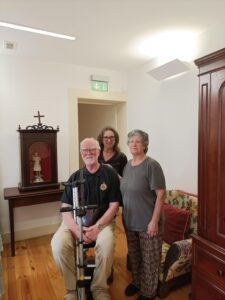HISTORY OF THE CONVENT OF SAN BERNARDINO
The presence of the Franciscans in Madeira is intertwined with the discovery and settlement of the island since 1419/20, by João Gonçalves Zarco.
Chroniclers point out that the first caravels that landed in Madeira came with two Franciscans, who sprinkled the air and land and celebrated the first mass in Machico, on 2 July 1420.
Initially they had no stable residence.
The foundation of the first convent dates back to 1440, in São João da Ribeira, on the outskirts of the city of Funchal.
In 1473 they founded the convent of São Francisco, in the city, in order to facilitate the pastoral care of the population.
It was a novitiate house, center for philosophical and theological studies and headquarters of the Custody of São Tiago Menor, established in 1702, bringing together the five existing convents in Madeira.
The Franciscans provided religious assistance in the first chapels erected in the city and surroundings, also assuming the pastoral care of the first parishes that were created, from 1430 onwards, such as Santa Maria Maior, in Funchal, Câmara de Lobos and Ponta do Sol.
The convent of São Bernardino was founded in 1459/60, by Fr. Gil de Carvalho in Câmara de Lobos.
It received this designation under the influence of the Observance movement that had in São Bernardino de Sena, canonized in 1450, one of the most notable defenders.
For twenty years it was a modest hermitage inhabited by a small number of friars.
After an alluviation, it was rebuilt in 1480, by Fr. Jorge de Sousa, and the convent now houses around ten friars.
Five years later, Fr. Pedro da Guarda, having lived in this convent for twenty years, where he served in humble trades, namely as a cook.
He died on July 27, 1505, with a reputation for holiness.
According to the Order’s chroniclers, he was notable for his spirit of prayer, penance, the gift of prophecy, poverty and humility, and also the gift of restoring peace among those who had fallen apart.
On January 28, 1597, the relics of Fr. Pedro da Guarda for the conventual church, by the Commissioner of the Order in Madeira, Fr. Ambrósio de Jesus, and by the Bishop of Funchal, D. Luís Figueiredo de Lemos, accompanied by the Rector of the Jesuits and other “qualified persons”.
Public veneration begins, with ecclesiastical approval.
On this date, 600 miracles were authenticated, attributed to the “Holy Servant of God”, for his canonization process.
Later, in 1619, the tomb of Fr. Pedro, by order of the Provincial, Fr. Jerónimo da Mãe de Deus, three relics being removed for veneration by the faithful in the other Franciscan convents on the island.
In 1620, a new process of Fr. Pedro. Others followed, but without a favorable conclusion, for various reasons.
According to D.Fr. António Montes, there were eleven processes, only two of which reached Rome.
In 1667, the erect chapel was built over the tomb of Fr. Pedro, collecting the remaining bones in a stone chest.
Subsequent construction of two other chapels: in the kitchen and outside, at the top of the stairs that give access to the cave where he prayed (“public chapel”), being the only one that has survived until the present day.
In 1705, Fr. Fernando da Soledade, in the Seraphic History, refers to the profusion of miracles, through the application of earth from the grave, as “salutific earth and universal remedy for all evils”.
He also states that “the people of that island placed his image in all the churches, worshiping him, as the canonized saints have”.
On the 9th of October 1803, there was a large alluvium that destroyed virtually all of the buildings between the church and the stream.
The fence, the cloister, the De Profundis room, the refectory, the cellar and the bedroom were lost, including the Chapel of the Servant of God in the kitchen.
Afterwards, the convent was reconstructed, upstream from the church, giving it its current appearance. After the extinction of the Religious Orders, the following year, on June 2, 1835, Cón. António Alfredo Braga, Vicar Capitular of the Bishopric of Funchal, attached to Freemasonry, ordered the destruction, in his presence, of all signs of worship of the Servant of God – his images and relics – with the pretext of extinguishing superstition and complying with canonical provisions .
He also sent a circular letter to all parish priests, asking that it be read for eight consecutive Sundays, having also threatened to suspend any and all parish priests who, in any way, promoted the cult of Fr. Pedro da Guarda.
On the 6th of July 1898, Manuel Joaquim Lopes, a devotee of the Servant of God – who had bought the convent building from the State in 1872, opening its doors to pilgrims – sold it, for a symbolic value, to the Diocese of Funchal, in the person of D. Manuel Agostinho Barreto.
On October 12, 1916, Sr. Mary Wilson de S. Francisco, founder of the Franciscan Sisters of Nossa Senhora das Vitórias, with the intention of founding the pre-seminar, at the request of D. António Pereira Ribeiro.
He died in the convent, with a reputation for holiness, on 18 October 1916. In 1926, the convent church was blessed.
The restoration works were guided by Fr. João Joaquim de Carvalho from 1924 to 1928.
São Bernardino was the main house of the Congregation until 1928, when Quinta das Rosas was acquired.
The Seminar closed in 1931, with the Victorian Sisters remaining in São Bernardino, directing a school until 1958. Finally, in 1961, by decree of D. David de Sousa, Bishop of Funchal, the former Convent of São Bernardino became seat of the new parish of Santa Cecília.
At the end of the 20th century, the convent ceased to function as the parish headquarters, with the construction of the new parish church, whose definitive facilities were inaugurated in 2011.
Since that time, the degradation and (almost) abandonment of the convent has increased.
After the mobilization of the Diocese of Funchal and the Franciscan Order and with the decisive support of the European Union, the Regional Government and the Municipality of Câmara de Lobos, restoration and requalification works were carried out, inaugurated on March 3, 2015.
São Bernardino is considered the first sanctuary of regional dimension, where pilgrims and pilgrims from all over the island and even the mainland flock.
As in Monte and Ponta Delgada, it preserves the kitchen and the home of the pilgrims.
With a school and parish headquarters operating there, many generations of Madeirans maintain ties of deep spiritual affinity with this Franciscan convent, which has just been restored.
The complete restoration of the Convent of São Bernardino allowed the return of the Franciscan community, the opening to the public of a valuable heritage of historical and spiritual interest, projecting, in the near future, the installation of a museum nucleus of Franciscan History in Madeira and the reactivation of the Cause of Canonization of the so-called “Holy Servant of God”, Br. Pedro da Guarda.
Fr. Nélio Mendonça, ofm.
An obligatory stopping place.
 |
 |
 |
Accessibility
♿ 🟢 Accessibility: Easy ( Access Depends On A Lift )



